
The Ratmobile Mk. 2

The Ratmobile Mk. 2 is a Light Adriatic Metallic 1995 Chevrolet Caprice with Medium Blue Leather interior. It was built at the Chevrolet plant in Arlington, Texas, and was the 36,832nd built out of 57,342.
Specs:
| Engine Type: | General Motors L99 |
| Cylinder Configuration: | V-8 |
| Engine Displacement: | 4.3L (4293cc, 265 ci) |
| Compression Ratio: | 9.9:1 |
| Valve Configuration: | Overhead Valve |
| Firing Order: | 1-8-4-3-6-5-7-2 |
| Bore & Stroke: | 3.74 x 3.00 in |
| Fuel System: | Sequential-Port Fuel Injection |
| Horsepower: | 256 hp * |
| Torque: | 315 lb-ft * |
| Idle Range: | 575-800 RPM |
| Ignition System: | Opti-Spark optical distributor |
| Alternator: | Delcotron CS-144, 140 Amps peak @ 2100 RPM, 72 - 108 Amps @ idle RPM |
| Engine Computer Firmware | Custom PCM For Less programming * |
| Block Material: | Cast Iron |
| Transmission: | Hydra-Matic 4L60-E (4 speed, longitudinal mount,
electronic) Custom PCM For Less shift solenoid programming * |
| Drive Train: | Rear Wheel Drive |
| Gear Ratios: | 1st: 3.059:1 2nd: 1.625:1 3rd: 1.000:1 4th: 0.696:1 Rev: 2.294:1 |
| Axle Ratio: | 2.93:1 |
| Brakes: | Four wheel anti-lock disc system * |
| Brake Pads: | Raybestos BruteStop pads (front) Raybestos PG Plus pads (rear) * |
| Braking Distance (60-0) | <120 feet * |
| Wheels: | 17" x 8.5" 5-spoke aluminum wheels * |
| Tires: | B. F. Goodrich g-Force T/A KDWS 255/50ZR17 W-rated * |
| Body Type: | GM B-Body |
| Frame: | Full perimeter steel |
| Front Suspension: | Independent - SLA Hotchkis stabilizer bar * |
| Rear Suspension: | Salisbury 4-link Hotchkis stabilizer bar * Hotchkis lower trailing arms * |
| Steering Ratio: | 12.7:1 |
| Turning Radius: | 37.7 ft |
| Fuel Tank Capacity: | 23 gal |
| Rated Fuel Economy: | 18/26 |
| Actual Fuel Economy: | 15/23 * |
| Maximum Range: | 598 miles/tank (rated), 529 miles/tank (actual) * |
| Coefficient of Drag: | 0.34 |
| Overall Length: | 214.1 in |
| Wheelbase: | 115.9 in |
| Overall Width: | 77.5 in |
| Overall Height: | 55.7 in |
| Passenger Compartment Volume: | 114.2 cu ft. |
| Head Room, Front: | 39.2 in |
| Luggage Capacity: | 20.4 cu. ft. |
| Dry Weight: | 4061 lbs |
| Operating Weight (minimum w/driver): | 4600 lbs * |
| GVWM: | >6000 lbs * |
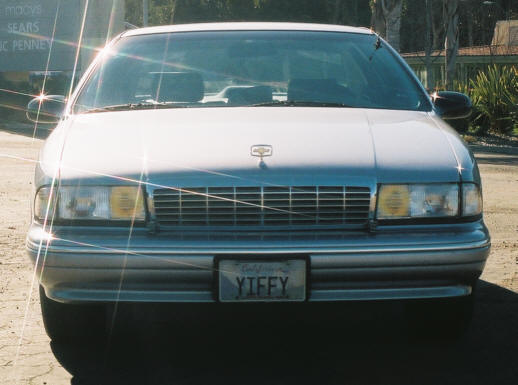
The Caprice was one of the last cars of the "Large Car" class (the only surviving member of that class is the Ford Crown Victoria/Mercury Grand Marquis), as large as a luxury car, but without the excessive price tag. It was a member of the General Motors "B-Body" series, a venerable series dating back to the 1960's, including cars such as the Chevrolet Impala, the Buick Le Sabre and Roadmaster, the Pontiac Bonneville, and the Oldsmobile Delta 88.
The Caprice is a highly reliable vehicle, able to withstand tremendous abuse on the road. Combined with her massive V8 engine, this helped make the Caprice one of the most popular vehicles for law enforcement and fleet use for 30 years! The Caprice Classic was famous for having the softest, cushiest ride of any vehicle on the road. A true land yacht, she practically floats over the road. She is a behemoth, weighing in at about 4100 pounds empty, and over 4600 pounds as equipped (she's actually heavier most SUV's and pickups!), and yet she can reach insane speeds in the blink of an eye. With the electronic speed limiter removed, the top-end is over 140 mph! With 8 cylinders, she achieves maximum horsepower without excessive revs (redline is just over 5K!), and puts out huge amounts of torque, making for a quiet ride and effortless acceleration. Like most V8's, fuel economy suffers a bit, with an average of 17 mpg during city driving, and about 25 mpg on the highway. Her L99 engine is virtually identical to the Corvette LT1, only with a smaller bore and stroke. She was one of the last cars built with a full steel frame, which greatly improves survivability and reduces damage in an accident.
The Caprice is actually one of the largest vehicles produced in the past several decades, a mere 1.4 inches narrower and a whopping 1 foot, 3.2 inches longer than a Cadillac Escalade, and 4.4 square feet larger than the Hummer H1!
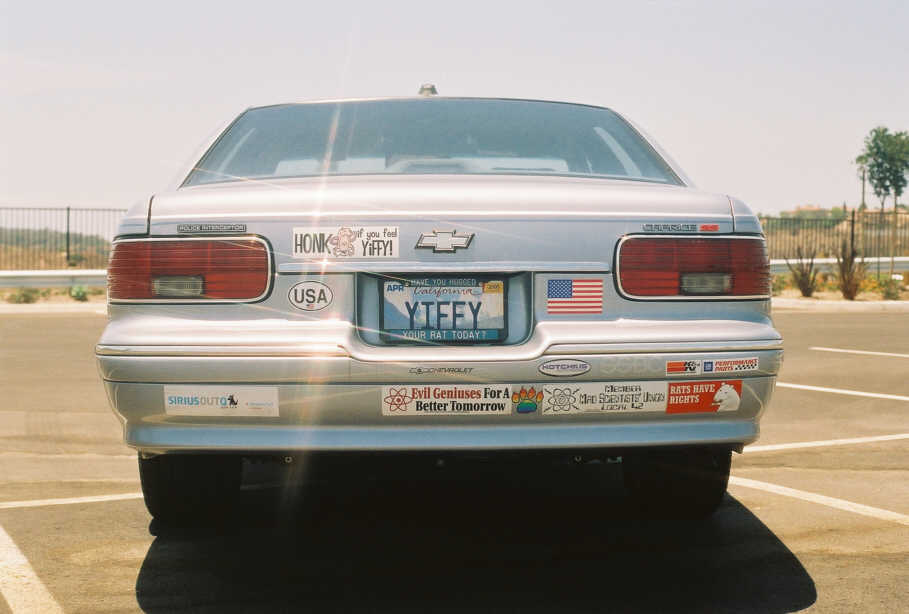
I've replaced the "Caprice Classic" badge on the trunk lid with a "Caprice SS" badge. The red SS looks a bit cheesy, so I'm going to see if I can get the "Classic" part of the badge and just cut it down to the "SS". I've put the Crown Vic "Police Interceptor" badge on the left side of the trunk lid. I've installed the old 1961 Impala "deer and cross-flags" on the front fenders. And I've replaced the radio badge on the dash with one that says "Caprice SS"
On the instrument panel, I've attached a sticker reading "NOTICE: Use overdrive during high speed pursuit", and the front windows have the warning "Close windows above 140 MPH". The side windows have 10 year AAA Member stickers, and AAA Premier Member stickers. I've also transferred the custom Yosemite license plates from the Mk. 1, so I still have "YIFFY" as my license number! The license frame is custom too, reading "Have you hugged your rat today?" There are now seven bumper stickers, a rainbow paw print, "Evil Geniuses for a better tomorrow", "Member Mad Scientist Union Local 42", a euro-style country tag reading USA, an American flag, a Sirius OutQ sticker, and a Rats Have Rights sticker. I've also got stickers for Hotchkis, GM Performance Parts, K&N Filters, Stainless Steel Brake Corporation, and Chevy Police Package.
I have the trunk spoiler from the Impala SS, I just need to have it painted and installed.
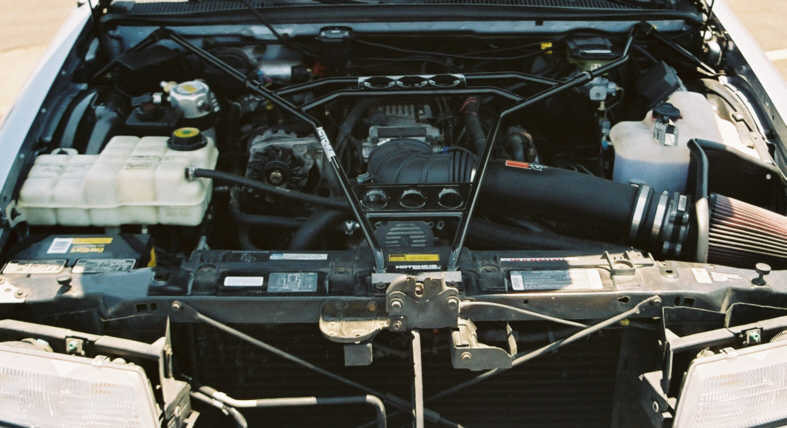
I've uploaded a new custom engine program from PCM For Less, which boosts engine power, reduces operating temperature, firms up the transmission, corrects the speedometer, and removes the speed limiter. Unfortunately, the side effect is that I must use premium gasoline forever. This is one of the easiest (plug laptop into the diagnostic port and run the installer), fastest (about 5 minutes), and cheapest ($50) performance modifications ever.
I've replaced the stock 195º thermostat with a Hypertech PowerStat 160º unit. This works in conjunction with the custom PCM programming which turns on the electric cooling fans much sooner than stock. This helps the engine run cooler, and a cooler engine means more horsepower.
I've also done the Throttle Body Bypass mod. GM designed the cooling system to route hot coolant through the throttle body to prevent freezing in sub-zero conditions. The side effect of this is that it heats the air coming into the engine, reducing power. Since it rarely ever gets below 50 here in San Diego, this system is totally ridiculous, so by redirecting the coolant around the throttle body, I can gain a few extra horses.
I've removed "First Base" and "Home Plate", the rectangular and pentagonal plastic pieces in the air intake system. They are designed to help the engine run quieter, but what they really do is reduce horsepower. I've installed a K&N Fuel Injection Performance Kit, which replaces First Base and the air box with a plastic tube, a heat shield and a large conical filter that allows greatly increased airflow. This gives a huge boost in power, gives the car a nice growl at high RPM. I've also replaced the stock intake elbow with the Camaro 1LE elbow, which is less restrictive and doesn't have the Home Plate hole on top.
I've replaced the stock knock module with the Corvette LT4 knock module. The stock LT1/L99 module is a bit too sensitive to normal engine noise at high RPM, drastically cutting back engine timing because it mistakenly thinks the engine is knocking when it's really just hearing normal engine noise. The LT4 module listens to a different frequency range, which makes it less likely to pick up false knock. This prevents a possible loss of power at full throttle.
I've performed the AIR pump delete, which prevents a potential problem with water vapor leaking past the check valves and affecting the MAF sensor, reducing engine performance. The custom PCM programming allowed me to disable the AIR pump without triggering the SES light, and without the need for an expensive dealer reprogramming.

I've replaced the front springs with Moog 5402 coil springs, and the rear springs with Moog CC621 cargo coil springs. The cargo springs raise the rear end and give the car a raked appearance. It also allows me to carry more weight in the trunk, and to tow more (once I get a tow hitch). I've also replaced the shocks with Monroe Sensa-Trac Load-Adjusting coil-over shock absorbers, which gives better control and prevents the rear from sagging while hauling cargo, while still maintaining ride comfort.
I've replaced the cheesy stock front sway bar with a beefy 1-7/16" Hotchkis bar, and I've installed a 1-3/8" Hotchkis sway bar on the rear (The stock Caprice Classic has no rear sway bar). Installing the rear bar also required installing the much stronger Hotchkis lower trailing arms (the stock GM arms are much too fragile). I've also installed the Hotchkis engine bay brace (which helps stiffen the front of the body), and the Roadmaster rear frame brace (which stiffens the rear frame).
I've upgraded the lower body mount cushions which help connect the body to the frame. The 94-96 B-bodies (except the police version) left out the lower cushions for the first 3 body mounts, so the body could move up to 1 inch separate from the frame. The remaining mounts got a 5/8" soft rubber cushion. I upgraded all the mounts to a "pink" 7/8" firm rubber cushion (except the #7 mount, which I used a "green" 3/4" firm rubber cushion). The result is much tighter handling and less vibration.
I've replaced the stock 15" aluminum lace wheels with the 17" Impala SS open aluminum wheels. I've also replaced the stock General 215/75R15 tires with BF Goodrich g-Force KDWS 255/50R17 W-rated tires. These tires are HUGE and give excellent cornering traction. They also give excellent wet and snow traction, unlike most high-speed tires. The open design of the wheels also helps keep the brakes cooler. Combined with the beefed up suspension, I can take curves as fast as most sports cars.
I've replaced the stock rear drum brakes with a disc brake conversion kit from Stainless Steel Brake Corporation. I've also done the brake proportionment mod, using a stealth bolt from ESDS, which changes the brake proportion from 90% front/10% rear to 70% front/30% rear. This reduces nose dive during sudden braking, and saves wear and tear on the front brakes (normally the rear brakes last 120,000 miles or longer, while the front brakes only last about 30,000 miles!) This mod can only be done on cars with 4-wheel disc brakes, and would be dangerous on a car with rear drums. I've also replaced the front brake pads with Raybestos BruteStop pads. They're designed for high-performance vehicles and will resist fading under high temperatures, though they're much less effective when cold.
I've replaced the stock Caprice Classic air dam with the 9C1 Caprice air dam. The stock air dam shields the front wheels to improve fuel economy, while the 9C1 air dam directs airflow over the brakes, cooling them and reducing dust. This is very useful in a vehicle as heavy as the Caprice.
I've replaced the stock headlamps with Osram Sylvania SilverStar 9004ST headlamps. These are much brighter, and produce a whiter light (4000°K), similar to an HID headlamp, but without the annoying blue glare. (For comparison, standard quartz-halogen headlamps are 3200°K, xenon HID lamps are 4100°K, and sunlight is 5400°K)
I've also modified the interior lamps by fashioning reflectors from aluminum tape. This has doubled the light output of the floor lamps and the underhood work lamp, and provided a definite increase to the door and overhead lamps. The trunk lamp has only a slight increase in light output, due to its design.
I've modified the oil pressure gauge so it displays accurately. (The stock Caprice/Impala oil gauge doesn't actually display oil pressure; if the oil pressure is above 4 PSI, the needle will always point to 75%, regardless of the actual pressure. By replacing the oil pressure sensor with the police version and removing a resistor from an electrical harness, the gauge will read the correct oil pressure) Unfortunately, the calibration markings on the non-police Caprice and Impala are designed for the fake sensor, so the oil pressure frequently reads into the "low" range, even though the oil pressure is just fine. (The instrument panel on the police version has the correct markings)
I've installed the rubber "gas bib" that was stock on the white Caprice Classic. It fits between the license plate and the plate holder, and funnels spilled gasoline underneath the vehicle instead of letting drip onto the bumper, thus protecting the paint. Every B-body owner should install this, as it takes about 5 minutes and costs under $15.
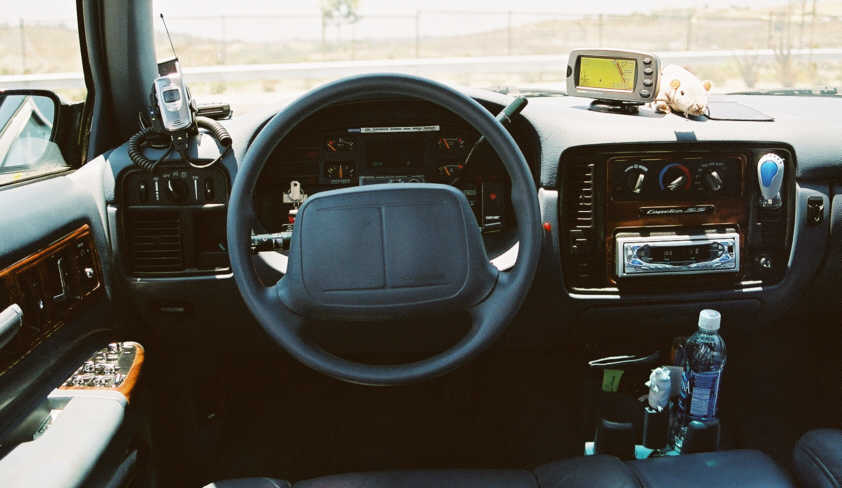
I've replaced the stock Delco tuner and speakers with a Kenwood KDC-MP819 CD/MP3 receiver, a Kenwood KDC-C717 10 CD changer in the trunk, a pair of Kenwood KFC-6908 6x9 220W 4-way speakers in the rear, a pair of Kenwood KDC-X468C 4x6 100W 2-way speakers in front, and a Kenwood KSC-WA82RC 8" 1000W Powered Enclosed Subwoofer with dual voice coils in the trunk, as well as a Kenwood KCA-RC700 steering wheel remote which lets me tune the radio, select a CD, and change or mute the volume without letting go of the wheel. The subwoofer also has a remote control, mounted just below the instrument panel. I've also added the Kenwood KTC-SR901 Sirius Satellite Radio tuner and the Kenwood CX-SR10 Sirius antenna, allowing me to receive the Sirius Satellite Radio network, which offers nationwide reception of over 60 commercial-free music channels and 60 channels of news, sports and entertainment, all with digital quality.

I've installed a Garmin StreetPilot 2610 talking GPS system with a 1 gigabyte storage card containing
street level maps for about 75% of the continental US (Sorry, Maine, but I won't
be visiting any time soon!) and an external antenna for faster satellite
acquisition. I've uploaded the latest firmware, which adds WAAS support
for greater accuracy, an altimeter, better on-screen display, and enhanced
graphics. The car is also equipped with a FasTrak transponder, allowing me
to breeze through toll gates without stopping and use carpool lanes even when
I'm alone in the car. There is a
hard-wired Whistler 1675 Radar Detector capable of detecting X, K, and Ka radar
bands as well as Safety Radar System (SRS) signals. The doors and trunk have a wireless remote to unlock them from a
distance, and the windows can be rolled up and down remotely as well.
There is also a remote starter to allow for warming up the car on those chilly
San Diego mornings ![]()
I've installed a Motorola Bluetooth car kit which automatically connects to my RAZR cellphone as soon as I start the engine, allowing me to make and receive calls hands-free. The phone can be anywhere in the car, even the trunk; the kit connects automatically using Bluetooth wireless. I can even place a call using its voice-dial feature by simply saying the number.
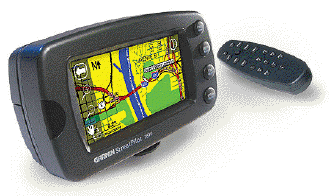
The car is equipped with a Clifford Matrix RSX 3.5 alarm system that detects broken windows, opened doors, truck, or hood, motion and impact, attempts to start the car, attempts to disconnect the battery or tampering with the alarm itself. It also locks out the starter, providing a double measure of protection. The alarm is normally set in a warning mode that allows for small motion, such as a passing truck or bus, sounding only a warning chirp (the alarm will trigger normally if a door or window is opened, if the glass is broken or if heavy or continuous motion is detected), but this can be manually bypassed for instant intrusion detection. There is also a panic alarm which immediately activates the siren and flashing lights. The alarm system is two-way, meaning not only can the alarm be controlled from the remote, but the remote receives signals from the alarm and can act as a pager if the alarm is triggered. It also has a code-hopping system that protects against code cloning. The remote operates in the UHF frequency band, and has a booster antenna that extends the remote transceiver range up to 1/4 mile! The system has its own battery backup, so even if someone cuts the battery wires, the alarm will continue to operate. The system also has a second siren inside the cabin, making it unbearable to remain inside the car when the alarm goes off.

The ignition system is equipped with PASS-Key II theft-resistance. The engine computer will not allow the engine to start unless a key with the correct electronic code is inserted. Trying to hot-wire the ignition or use a non-coded or incorrectly-coded key will fail. In addition, the stereo system is code protected; if removed from the car, it will not allow operation until the proper key code is input. The faceplate is also removable. The radio antenna extends automatically only when the stereo is in radio mode; it stays retracted when listening to CD's or satellite or when the stereo is off. The rear doors have child protection locks, and the power windows can be locked out by the driver. The wheels are protected with locking lugs, the gas tank has a locking cap, and even the license plates have tamper-resistant screws!
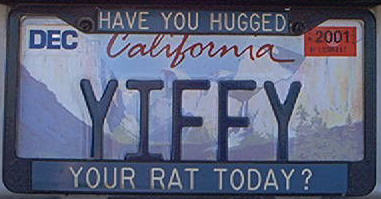
One interesting note: The fuel tank drives full service gas station attendants nuts. Virtually all cars built currently have a fuel door on one side or the other. The Caprice was designed with the fuel door in the middle, hidden behind the license plate. It's fun watching full-service gas station attendants play "Hunt the Fuel Door" It's very nice to be able to use any lane at a gas station without waiting in line. I always want to yell "Ha ha! Suckers!" as there are twenty people all with the gas cap on the right side waiting in line, and nobody on the left side lanes.
The trunk latch also confuses people. The keyhole is hidden under the Chevy emblem on the trunk. Even expensive luxury cars like the Lexus skimp on important details like these and leave the fuel door and keyhole exposed like ugly scars. Of course, with the remote control, I hardly ever use the key.
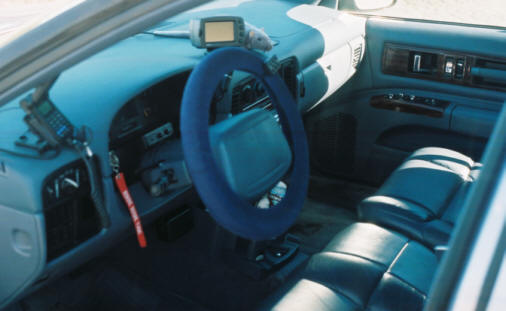
The interior is big and roomy, and the leather seats are extremely comfortable. Both front seats have 6-way power adjustment controls, and also recline almost horizontally. Even though the Mk 1 and 2 have the same exterior dimensions, the interior of the Mk. 2 is actually larger! Three people easily and comfortably fit in the back seat, and three fit in the front seat, though the center seat is not very comfortable for long trips. All four doors have large map pockets, and there are pockets behind the front seats. The air conditioner produces freezing cold almost instantly, and the heater is quite warm, though with the cooler thermostat, it's not as hot as it used to be (like I need a heater in southern California). The soft ride suspension, low-revving engine, and heavy insulation give an extremely quiet, smooth ride over almost any surface, even dirt or gravel roads!
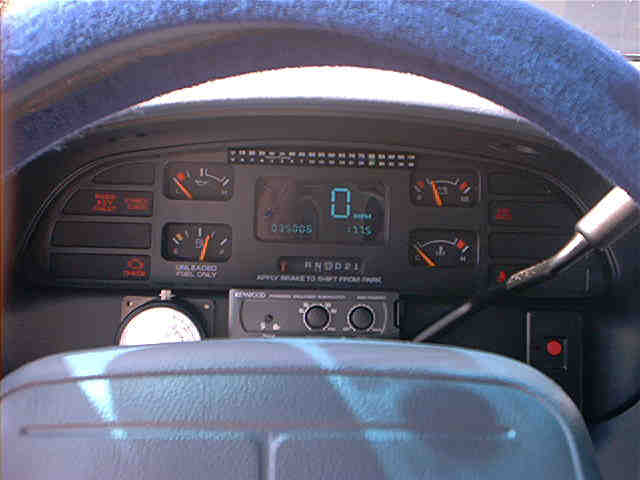
The Mk. 2 Ratmobile was commissioned on May 27th, 2001, replacing the Mk. 1, a 1993 Caprice Classic with 150,000 miles.
The Ratmobile theme song!
(actually, Flight of the Bumble Bee, the Green Hornet theme)